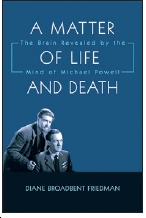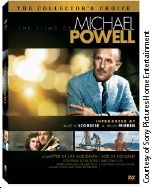Last November I received a letter from
Diane Broadbent Friedman, enclosing
a copy of her book, A Matter of Life and
Death: The Brain Revealed by the Mind
of Michael Powell. Friedman wrote that
when she was a nurse practitioner on a
neurological unit, she had seen this old
film and had immediately wondered
whether some of the seemingly
fantastic scenes and events in it had
a neurological basis. I had seen A
Matter of Life and Death as a boy - it
came out just after World War II, and
I remembered being haunted by the
power and strangeness of the film with
its large escalator running up to heaven
and the weird six-note musical motif
that ran through it. Now, 60 years later,
alerted by Friedman's letter, I watched
A Matter of Life and Death again
with my colleague Orrin Devinsky, a
specialist in seizure disorders.
The film, which was called Stairway
to Heaven in the USA, opens with the
hero (David Niven, as an RAF pilot)
flying a doomed bomber. The plane
is in flames, but Niven has given his
parachute away to a crewman, and he
intends to jump to his death rather
than be burnt alive in the plane. He
has a final conversation with a radio
operator - an American girl stationed
in wartime England - and then jumps
into the thick Channel fog to his
certain death. Mysteriously, however,
he survives, and by happy accident
immediately meets the girl he had
had his "final" conversation with. He is
bewildered to find that he is still alive,
but apart from a headache and feeling
a little strange, he is unharmed.
The next day he has a strange vision:
a foppish figure in 18th-century dress
appears and identifies himself as an
angel of death, a conductor to the
afterlife, sent to meet Niven at the
moment he jumped from the plane.
The angel had been unable to locate
him in the dense fog - would he now,
please, accompany him to heaven? |
This is the first of many supernatural
visitations, and an intricate heaven and-
earth drama unfolds on screen.
As neurologists, we could see
how many of the film's seeming
irrelevancies - details that had eluded
me as a boy - could be understood
as hallucinatory auras announcing a
temporal lobe seizure. Before each
mystical vision, for example, the pilot
cocks his head as he "hears" music,
"Friedman shows that A Matter
of Life and Death is not only the
surreal and romantic fable it
was taken to be by most
viewers, but a carefully worked
out neurological case history
as well."
and sniffs as he "smells" something -
it is always the same music, always
the same smell. Alarmed by Niven's
behaviour, his girl seeks the advice of
a physician friend. The doctor takes a
history, observes Niven's attacks, and
makes careful note of his hallucinations
and altered behaviour. He is also
able to show, after one attack, a
dilated pupil, an upgoing toe, and a
massive field-cut in half of Niven's
visual field. The physician diagnoses
"adhesive arachnoiditis", apparently a
consequence of a previous head injury,
and advises immediate surgery. During
this surgery, Niven pleads his case in
heaven for remaining in this life.
As neurologists, Orrin Devinsky and
I have seen many patients who have
temporal lobe seizures - such seizures
may include mystical visions and a
post-ictal conviction of their "truth"
(although never visions and delusions
as detailed and logical as Niven's).
Yet when the film came out in 1946,
reviewers were strangely silent about
these medical details - no one, indeed,
seems to have noticed.
That all of these tantalising neurological
details had been missed, or |
seen as irrelevant, by filmgoers and
reviewers alike astonished Friedman
when she first saw the film in 1990.
Fascinated, she embarked on what was
to become a painstaking project to
reconstruct the researching of the film.
Michael Powell, who directed the film,
had died, but his widow was still alive.
On the basis of interviews with her and
many others who had known Powell,
Friedman discovered that he had read
widely in medical journals and had
interviewed neurologists and watched
them examine patients. (A nice touch
in the film is when the neurologist
pulls a key out of his pocket to test the
plantar reflexes - typical on-the-spot
behaviour for a physician who has to
make an instant examination with
whatever he has on him.)
Feeling she had hit paydirt, Friedman
published an article in Seizure, in 1992,
hoping for a response from its readers,
but there was no reaction. Undaunted,
she expanded her research, and now,
16 years later, provides us with all
the evidence in her meticulously
researched book (one sees from the
bibliography alone that she has read
more neurology, and specifically more
about temporal lobe epilepsy, than
most neurology residents).
Friedman shows that A Matter of Life
and Death is not only the surreal and
romantic fable it was taken to be by
most viewers, but it is also a carefully
worked out neurological case history.
By a happy coincidence, the original
1946 film has just been re-released
with restored footage in The Collector's
Choice: The Films of Michael Powell. One
hopes that everyone, but especially
physicians and neurologists, will visit or
revisit this unique double treat, a first
class piece of film, full of human drama
with, if one has eyes to see it, a minutely
worked-out neurological basis.
Oliver Sacks
OS2177@columbia.edu |
 |
| A Matter of Life and Death: the
Brain Revealed by the Mind of
Michael Powell
Diane Broadbent Friedman.
AuthorHouse, 2008.
Pp 292. US$19·95.
ISBN 1-438-90945-4. |
 |
|
The Collector's Choice: The
Films of Michael Powell
A Matter of Life and Death
(Stairway to Heaven)
Directed by Michael Powell,
Emerich Pressburger.
Age of Consent
Directed by Michael Powell
Sony Pictures, 2009. US$24·00.
ASIN B001IZNIV4. |
See also the author's pages
Back to index
|



